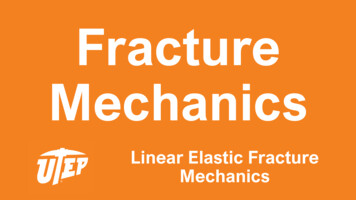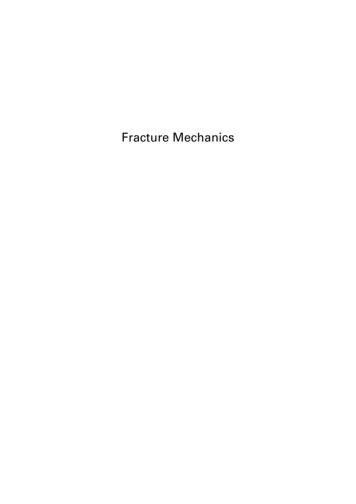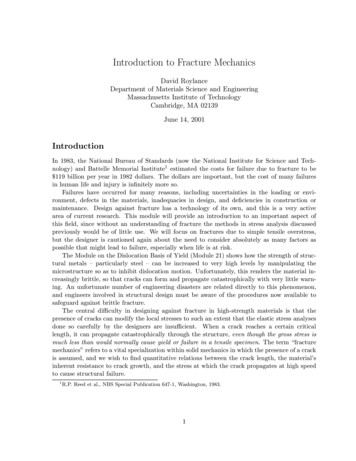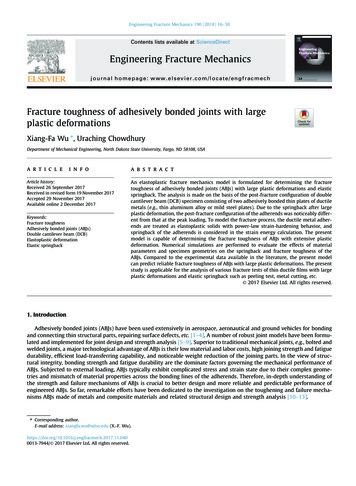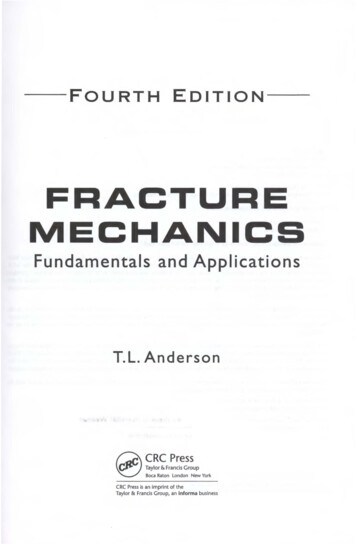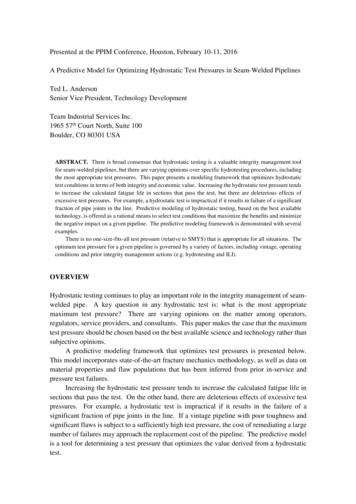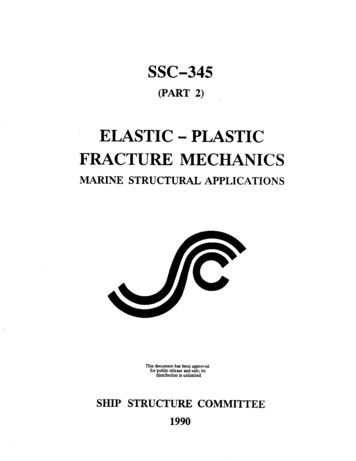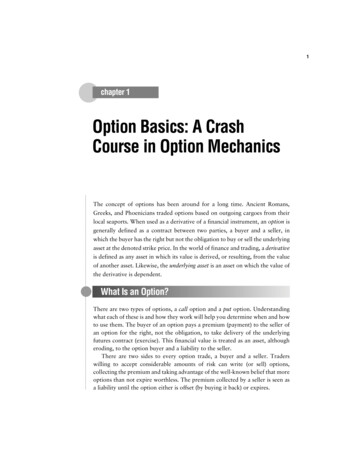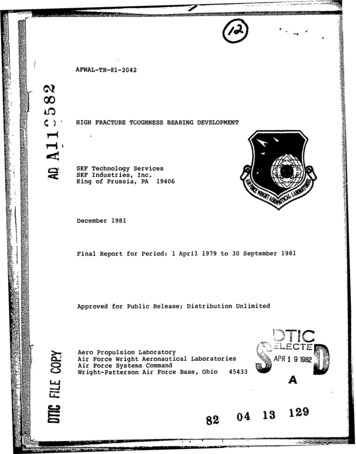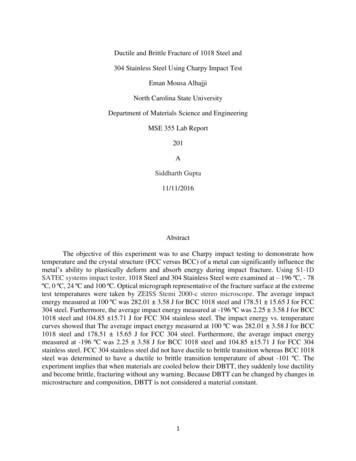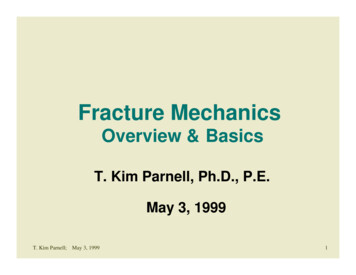
Transcription
Fracture MechanicsOverview & BasicsT. Kim Parnell, Ph.D., P.E.May 3, 1999T. Kim Parnell; May 3, 19991
Motivation Brittle failure at low stress in lowstrength steels– WWII era Liberty Ships Welded structuresDuctile/Brittle transition temperature too high The occurrence of failure at low stress in high-strength materials spurredFracture Mechanics furtherNBS economic study in 1978 estimatedthe cost of fracture at 119 Billion in theU.S. (about 4% of the GNP)T. Kim Parnell; May 3, 19992
Fracture v Strength CriteriaT. Kim Parnell; May 3, 19993
Historical Development A.A. Griffith work on brittle fracture G.R. Irwin extended Griffith’s work toductile materialsT. Kim Parnell; May 3, 19994
Work of Griffith A. A. Griffith started his work in around the 1920s.At this time, it was accepted that the theoreticalstrength of a material was taken to be E/10, whereE is Young's Modulus for the particular material.He was only considering elastic, brittle materials,in which no plastic deformation took place.However, it was observed that the true values ofcritical strength was as much as 1000 times lessthan this predicted value, and Griffith wished toinvestigate this discrepancy.He discovered that there were many microscopiccracks in every material which were present at alltimes. He hypothesized that these small cracksactually lowered the overall strength of thematerial because as a load is applied to thesecracks, stress concentration is experienced.T. Kim Parnell; May 3, 19995
Work of Irwin G. R. Irwin, in the 1950s, began to see how thetheory outlined by Griffith would apply to ductilematerials.He determined that there was also a certainenergy from plastic deformation that had to beadded to the strain energy originally consideredby Griffith in order for the theory to work forductile materials.Irwin developed the concept of the strain energyrelease rate.T. Kim Parnell; May 3, 19996
Concepts & Principles Crack tip stress distribution– 1/ r singularity at the crack tip (LEFM) Energy Release Rate is related to the Stress Intensity FactorCondition at the crack tip ischaracterized by the Stress IntensityFactor, KIFracture toughness is a materialproperty, KIc.T. Kim Parnell; May 3, 19997
Three Modes of Cracking– Mode I - opening mode– Mode II - in-planeshearing/sliding mode– Mode III - out-of-planeshearing/tearing modeDeal with Mode I most frequentlyT. Kim Parnell; May 3, 19998
Stress ConcentrationMaximumStressσ M 2σ 0T. Kim Parnell; May 3, 1999StressConcentrationFactoraρt σ0σmaK 2 1 .0σ0ρt9
Crack Tip StressesK I Cσ π a[stress * length0.5];Ex: (ksi- in, MPa- m) Near-tip stress field (LEFM)3θ θ θKcos 1 sin sinσy 2 22 2π rσ x τ xyT. Kim Parnell; May 3, 19993θ θ θKcos 1 sin sin 2 22 2π r3θ Kθ θ sin cos cos 222 2π r 10
Some Applications ofFracture Mechanics Remaining life as a function of crack sizeCrack size that can be tolerated(critical crack size)Time for a crack to grow from aninitial size to the critical size(inspection interval)T. Kim Parnell; May 3, 199911
Test Techniques forFracture Properties Compact Tension (CT)specimen Charpy impactspecimenT. Kim Parnell; May 3, 199912
Stress Intensity Factors for CTT. Kim Parnell; May 3, 199913
Miniature Specimens Trend: Development oftechniques usingminiaturespecimensExample:Small Punchprocedure forgeneratingconstitutiveproperties &fracture toughnessT. Kim Parnell; May 3, 199914
Piping Design:Leak Before Break Criteria Desirable for pipe to be able to grow a crack through-wall (leak) withoutunstable crack growth (break).Leak provides an opportunity todetect the crack before it becomeslong enough to be critical.T. Kim Parnell; May 3, 199915
Pipeline-Unstable Crack Growth 16-inch underground natural gas line300 psi internal pressurePoor quality welds (ERW pipe)Fast fracture of a 40-ft. section after initial welddefects grew through fatigue to critical sizeResulting fire & explosions demolished the plantT. Kim Parnell; May 3, 199916
Fatigue Growth Cyclic stress intensity factor K K max K min Y σ Paris lawda A ( KdNπa)m Integrate to get Cycles tofailureNf 0NdN afa0T. Kim Parnell; May 3, 1999daA(Y σ π a )m 1Aπm/ 2( σ )ma a f0daY m am/ 217
Fatigue Fracture SurfaceT. Kim Parnell; May 3, 199918
Conclusions Cracks are everywhere, it is just a matter of how large!Fracture design criteria arerequired more often inmodern designMore efficient designs withlower factors of safety drivethis trendT. Kim Parnell; May 3, 199919
Selected References:Fracture Mechanics Broek, David (1982). Elementary Engineering FractureMechanics, 3rd Ed., Martinus Nijhoff Publishers.Anderson, T.L. (1991). Fracture Mechanics:Fundamentals and Applications, CRC Press.Dieter, George, E. (1976). Mechanical Metallurgy, 2ndEd., McGraw-Hill.ASTM E399-83, (1983). “Standard Test Method forPlane-Strain Fracture Toughness of MetallicMaterials.”, Philadelphia.ASTM E813-87, (1987). “Standard Test Method for JIC,a Measure of Fracture Toughness”, Philadelphia.ASTM E1152-87, (1987). “Standard Test Method forDetermining J-R Curves”, Philadelphia.T. Kim Parnell; May 3, 199920
Fracture Mechanics further . Anderson, T.L. (1991). Fracture Mechanics: Fundamentals and Applications, CRC Press. Dieter, George, E. (1976). Mechanical Metallurgy, 2nd Ed., McGraw-Hill. ASTM E399-83, (1983). “Standard Test Method for Plane-Strain Fracture Toughness of Metallic Materials.”, Philadelphia. ASTM E813-87, (1987). “Standard Test Method for J IC, a Measure of .

